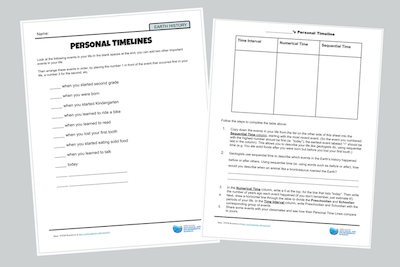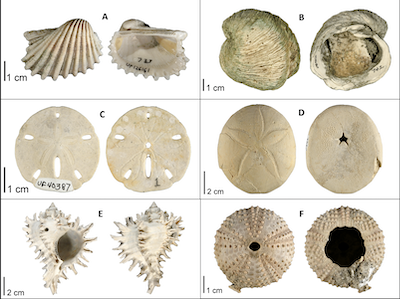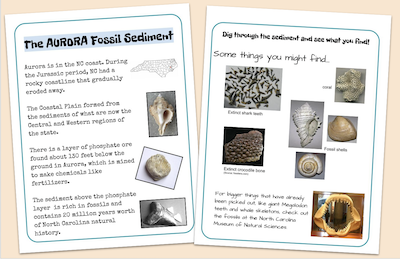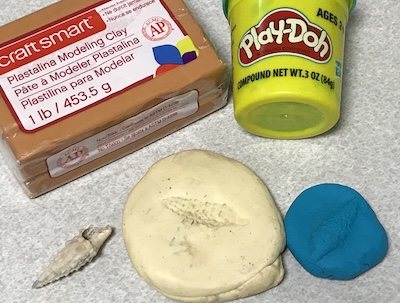NCSTA Workshop Attendees- DEEP TIME TOOLBOX Slides and attendee (8th Grade) package (4th Grade version of these materials can be found here)
The "Deep Time Toolbox" educational materials were created as part of the professional development workshop of the same name. The program was funded by the Paleontological Society of America and geared towards 4th and 8th grade educators in North Carolina. The materials however, are not specific to North Carolina and can be used at any higher elementary/ middle school level, as well as high school. The GES department at AppState has Deep Time Toolbox loaner kits. If you're in the Western NC area and would like to borrow one, please contact our K12 Outreach Coordinator Marta Toran (toranml@appstate.edu).
Feel free to use any of the materials below. If you'd like to modify any of the resources, please contact Marta Toran for the editable versions.
Geologic Timeline Activities
Personal Timelines- Teacher instructions and student handout. This is a great activity created by Judith Scotchmoor that helps students understand geologic timelines and the concept of relative dating by creating a timeline of events from their own lives. The original lesson plan can be found at http://www.ucmp.berkeley.edu/Personal Timelines (4th Grade) Personal Timelines (8th Grade) |
|
|
|
4th Grade Teacher Instructions & Images 8th Grade Teacher Instructions & Images
|
Fossils
|
 Mystery Fossils- Teachers often inherit treasure troves of fossils from others who inhabited the classroom before them. Random fossils offer a great opportunity for students to practice their inquiry skills to figure out what they are, what modern organisms they were related to, what period they lived in, etc. If you have fossils that you can't identify, please send photos to askageologist@appstate.edu for ID. "Engager" slideshow as an introduction to types of fossils. Mystery Fossils- a collection of slides with images of a variety of common fossils. Students match their mystery fossil to the images in the slides to find out the name of the specimen and some basic information about it. |
|
|
|
 Devonian Fossil Set- This set includes 15 casts of real Devonian fossils that can be used by students to practice categorizing and identifying common marine fossils from the Devonian period. Please request a set for your classroom by contact Outreach Coordinator Marta Toran (toranml@appstate.edu). |
Fossilization Methods
Fossilize-Me! Concept Sorting activity- Introduces students to various, simplified methods of fossilization based on the type of fossil it results in (mold, cast, trace and body). It can be used as an engager or as a review activity or game. Fossilize-Me! Concept Sorting Activity for 8th Grade(Teacher Instructions) Fossilize-Me! Concept Sorting Activity for 4th Grade (Teacher Instructions) -includes puzzle pieces for printing- What's Your Type? Student Handout- Knowledge check to determine understanding of different types of fossilization methods.
|
|
|
Geologic Dating
Slides for Crosscutting Relationships Activity Crosscutting Relationships Student Handout
|
Biostratigraphy Activity for 4th grade (includes explanation of activity and printable, simplified model) Biostratigraphy Activity for 8th grade (includes teacher instructions for making models, background information and handout with questions. |




 Timeline Teacher Cheat Sheet
Timeline Teacher Cheat Sheet
 Fossil or Not Student Handout
Fossil or Not Student Handout Fossil Classification Cards
Fossil Classification Cards


 Fossilization Stations- Includes
Fossilization Stations- Includes 
 Exploring Crosscutting Relationships Activity- In this activity (designed by Tim Martin), students examine a pre-made foam board that has undergone different “processes” and determine the order of actions done to the board. This modeling activity shows how scientists use cross-cutting relationships in geology as clues to determine the ages of rock layers and geologic timelines.
Exploring Crosscutting Relationships Activity- In this activity (designed by Tim Martin), students examine a pre-made foam board that has undergone different “processes” and determine the order of actions done to the board. This modeling activity shows how scientists use cross-cutting relationships in geology as clues to determine the ages of rock layers and geologic timelines.  Biostratigraphy- In this activity, PVC pipe and foamboard models of rock cores are used for students to practice analyzing rock layers and index fossils .
Biostratigraphy- In this activity, PVC pipe and foamboard models of rock cores are used for students to practice analyzing rock layers and index fossils .